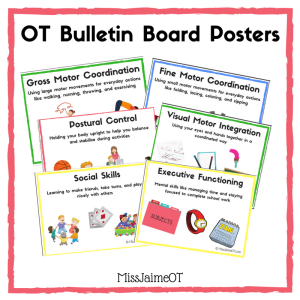“I just don’t know what to do!”
The Occupational Therapist was upset and frustrated. Her desk was covered in papers, folders, and notebooks. She ran her fingers through her unkempt hair and sighed. I understood. I’d been there, too.
“This child’s OT scores are really low, but the teacher doesn’t see any functional difficulties in the classroom. I can’t recommend OT if there’s nothing functional to work on!”
Occupational Therapists and Committees on Special Education (CSEs) are often in a dilemma when it comes to determining the amounts of services to recommend for a child.
How do therapists decide whether to provide children push-in versus pull-out services?
How many times a week does the child need?
When should services be terminated?
These can all be difficult decisions.
School-based professionals need to use their clinical reasoning skills to determine what to recommend for the children they are working with.
The Committee On Special Education’s recommendations and opinions also need to be considered. Each professional at the table has a unique educational background and point of view.
One thing to consider is that different services can sometimes overlap. For example:
- Occupational Therapists and Physical Therapists can work on gross motor skills
- Both OT and Speech Therapists can work on feeding and oral motor skills
- Resource Room teachers and Occupational Therapists can both work on organizational skills, executive functioning, and writing skills.
We ALL help children to succeed in the school environment. But, a child must not be pulled out of class to work on one skill (such as executive functioning) by two different professionals every week.
It’s important to use clinical reasoning when determining the frequency and duration of all the services a child receives.
Least Restrictive Environment and Response to Intervention also need to be considered.
Use the Resources that are Available to You!
The American Occupational Therapy Association has many resources to help guide your clinical reasoning.
First, it’s important to know your state guidelines so that you can advocate for yourself and your clients.
Information about your state’s guidelines for occupational therapy practitioners can be found:
New guidelines including Least Restrictive Environment and Response to Intervention can be found here: https://www.aota.org/~/media/Corporate/Files/Archive/Advocacy/FedReimbA/Issues/IDEA/Id04/Regs/IDEAanalysis.pdf)
Free "OT" Posters




In Florida we use the CERT to guide the discussion…
bit.ly/fullflcert
Hello Elisa,
Our district had been reviewing the CERT used in Florida in the past but we are hoping to provide more guidance on duration and frequency. We had some discussions on what warrants increased minutes or even who should receive 20 minutes vs. 30 minutes direct weekly minutes. Does Florida have guidelines for determining duration?
I can’t access the pdfs